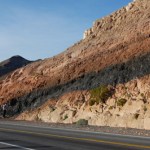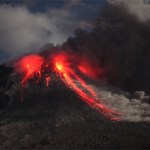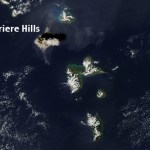NASA Earth Observatory
I'm still playing catch-up after my week in the desert, so I've seen a lot of articles I've wanted to mention ... but a certain other volcano has taken up a lot of my time. However, I will attempt to make amends for that now.
By the way, would you believe Ubehebe Crater was closed? How do they close a volcano, anyway? However, I did get a great snap of a welded tuff on the road outside of Shoshone, CA.
A strongly welded tuff near Shoshone, CA. The dark interior is remelted volcanic ash/tephra surrounded by less welded pink tuff with abundant pumice clasts. Denison student David Sisak is on…
Leaving for Death Valley tomorrow - I'll be sure to take some pictures of Ubehebe Crater and the volcano at the Mirage. This will likely be the last new post until about a week from now, but look for the Erta'Ale Volcano Profile, maybe a new Mystery Volcano Photo and I'll leave a thread open for any new volcano news.
Colima in Mexico.
Eruptions reader Tim Stone sent me this image from Japanese astronaut Soichi Noguchi's Twitpic feed - it is a stunner of the caldera on Jebel Marra in Sudan. The only known historical eruption for this volcano was ~2000 BC within the Deriba Caldera, but it has…
Did I mention its a busy week?
The lava lake at Erta'Ale in 2008. Image courtesy of Stromboli Online.
Our Icelandic saga continues, with more earthquakes and more speculation/information on the parts of Eruptions readers. Keep up the discussion - I'll be fascinated to see who turns out to get closest to what actually happens, prediction-wise. The seismicity has quieted somewhat again in the last 12 hours, so we wait eagerly to see what comes next. Remember, Iceland is the land where volcanoes helped change history, so it is always fun to talk Icelandic volcanism.
The NASA Earth Observatory…
Cleaning up some news ... busy week leading up to a field trip I am helping co-lead to Death Valley next week.
Ubehebe Crater in Death Valley, California
First off, I want to say how amazed I am at the great discussion that went on all weekend about the signs of potential activity in Iceland. It now appears that the earthquakes at Eyjafjallajökull may be waning, however the levels of seismicity have definitely bounced up and down over the last few days. However, the level and depth of the conversation is a testament to all volcanophiles out there. Nice job, folks.
For those of you into…
Not a lot of big news, but a lot of little news:
Soufriere Hills at night during the late January 2010 dome growth episode. Note the hot rock falls from the collapsing dome. Image courtesy of Photovolcanica.
This might not be new, but Dr. Boris Behncke brought the new webcam at the rim of Chaiten in Chile to my attention. You get a birds-eye view of the growing dome from the edge of the caldera - pretty nifty view for a once-in-a-hundred-years sort of event.
The NASA Earth Observatory has posted a close-up of the Soufriere Hills imagethat I posted yesterday, showing the February 11 plume.…
A couple bits of news:
The ash plume from the February 11, 2010 eruption of Soufriere Hills taken by theAqua MODIS camera. Image courtesy of the NASA Earth Observatory.
Flights have been disrupted in the West Indies since last week with the large dome-collapse eruptions of Soufriere Hills on Montserrat. The 10 km / ~35,000 foot ash plume is apparently lingering in the air at commercial flight levels, meaning delays, cancellations or long detours for many flights in the area. Flights in and out of Dominica, Guadelope, Montserrat, Anguilla, St. Kitts and Nevis have all been effected by the…
News!
Pakistan is home to the world's tallest mud volcano in the region of Balochistan - and its somewhat near the reports of an "eruption" earlier this week.
Guess what? Since Wednesday evening, seismicity at Yellowstone has dropped precipitously. The last batch of earthquakes on February 3rd were also back to deeper levels - 8-9 km depth - compared to the potential shallowing earlier in the week. I'm sure the caldera will keep us on our toes, but as of now, it seems to have settled down a bit.
Over in Pakistan, there is mounting evidence that the recent "volcanic" eruption reported as, in…
First off, I wanted to thank all of the Eruptions readers for making January the most popular month ever on this blog. I suppose I should give an assist to Yellowstone, but really, thanks for coming to the blog, reading the posts and engaging in all the great discussions that go on within its (cyber)walls.
KÄ«lauea's east rift zone eruption site. Image courtesy of the USGS/HVO.
On to some news!
I suppose you've made the big time when you're in the New York Times, and sure enough, the current Yellowstone earthquake swarm is in the Old Grey Lady. Nothing much new to read, but summarizes the…
Somehow I haven't posted a bunch of interesting items collected over the last few weeks, so I need to catch up. A pre-emptive hat tip to everyone who has sent me links or notes that might seem familiar in this post.
Tungurahua in Ecuador erupting in 2000.
First off, those of you looking for information on the Haitian earthquake that devastated the capitol Port Au Prince, Highly Allochthonous has post on the tectonics of the quake. Right now, it is hard for me to come up with a worse location in terms of devastation for a quake to have hit in the Caribbean Basin.
Back in volcano news, a lot…
2009 is over! If you missed the Volcanic Year in Review, check out my summary of the volcanic events that captivated many of us over the past year. However, only one event will get the coveted 2009 Pliny for Volcanic Event of the Year. A lot of you wrote in with votes and comments - I thank you - and a number of events stood out in your mind. Here we go:
Honorable mention
A few volcanic events got multiple votes:
- Soufriere Hills on Montserrat.
- Mando Hararo in Ethiopia.
- Chaiten, Chile and the new research on the eruption.
- The earthquakes in western Saudi Arabia under the Harrat…
Here it is, my attempt to recap a year's worth of volcanic events. By no means is this supposed to capture every event, but rather the highlight/lowlights and what most captivated me during 2009. I'll be announcing the winner of the 2009 Pliny for Volcanic Event of the Year tomorrow.
Waimangu Geothermal Valley in New Zealand, taken in January 2009 by Erik Klemetti.
January
The year started out with a trip to New Zealand (well, for me at least) and vistas of the Waimangu Valley, formed in the 1886 eruption of Tarawera on the North Island. We were also still thinking about the late 2008…
Looks like last night was busy, volcanically speaking. Eruptions readers noted that VAAC warning of ash from both Mayon (to 10,000 feet / 3.0 km) and Bezymianny (to 32,000 feet / 10 km) were issued {hat tip to Chance Metz for the updates}. Here is some more news on these ongoing events:
Mayon erupting in December 2009.
Mayon, Philippines
Evacuations are continuing near Mayon in the Philippines, some of them forcibly by the local authorities. PHIVOLCS is reporting that SO2 output from Mayon has jumped from ~750 tonnes/day to almost 2,800 tonnes/day over the last 24 hours and seimicity…
It's the last week of classes and it's also AGU (which I will be missing for the first time in 5 years). If you happen to be at the big meeting in SF and hear something you think we'd like to hear, feel free to drop me a line or leave a comment so we can live vicariously through you.
Pyroclastic flows at Sourfriere Hills, December 2009. Image courtesy of MVO.
Some news:
UPDATE 12:40PM 12/14/2009: Just to update the Mayon news from earlier today, PHIVOLC is reporting that lava has been spotting flowing from the main crater on Mayon. Sounds like the eruption we've been waiting for is…
Maybe I should just apologize right here and now for that title, but dang, I liked it.
Anyway, I've seen a lot of plume images cross my browser/inbox over the last day, so I thought I'd post a few of them.
Soufriere Hills, Montserrat
The renewed activity at Soufriere Hills has produced a bounty of plume images over the last week. The NASA Earth Observatory posted an image of the plume, which sometimes reached as high as 3.7 km / 12,000 feet (if not higher). Eruptions reader Alex Waning sent me some images of the top of the plume at ~3.7 km / 12,000 feet taken from a flight near Montserrat on…
An ash plume from Soufriere Hills on Montserrat, taken from the ISS on October 11, 2009.
If you ever wonder what might happen to the U.S. if a large volcanic eruption, lets say from Rainier or Long Valley or Shasta, occurred, you can look at the island of Montserrat for some of the potentials problems. The renewed activity at Soufriere Hills (video link) that started in October is causing problems with the power infrastructure of the island - specifically the ash from the eruption is falling on power lines and damaging them. Ash has a minor electrical charge, so it will coat anything with a…
Back to work after Thanksgiving Break ... lets clean up a few news items I missed trying to figure out the non-eruption of Karkar.
Undated photo of the summit area of Gaua, Vanuatu.
There was an actual eruption - or, more correctly, a continued eruption - of Gaua in Vanuatu. The current activity has prompted the evacuation of 300 villagers from the island and they will not be able to return until activity wanes. Tourists were also told to stay away from the volcano, but the airport on the island has not been affected by the eruption, which might suggest the activity is relatively localized…
The latest of volcano news from around the world, brought to you by the USGS and Smithsonian Institute Global Volcanism Program (and especially Sally Kuhn Sennert!)
Highlights this week include:
Karangetang in Indonesia produced a couple 3 km/10,000 foot steam-and-ash plumes according to reports from pilots.
Soufriere Hills on the island on Montserrat has had quite a few pyroclastic flows over the last few weeks since the volcano started erupting again. Mix that with some heavy rainfall and lahars were produced as well.
The alert level is still at Orange at Karymsky in Kamchatka, which…
All the news to start the week:
Galeras with a grey ash-and-steam plume behind Pasto, Colombia.
Well, after my article on Friday about Colombian volcanoes, Galeras must have decided it was left out. The volcano has been placed back at alert level Orange/II (eruption in days to weeks). An increase in seismicity and sulfur dioxide emissions (in spanish) prompted INGEOMINAS to put Galeras back on higher alert, but now the country has two volcanoes (Galeras and Huila) that could be erupting in the near future.
Back in the Philippines, there is new evidence that Mayon has a new dome forming at…
There has been news over the last few days of a number of volcanoes in Colombia, so I thought I'd try to gather it up here:
The steaming summit of Nevado del Huila in Colombia
Nevado del Huila has been ramping up its ash emissions, potentially pointing towards new eruptions from the crater dome. The NASA Earth Observatory posted a new image of the grey ash plume from the volcano poking its way up through the clouds. This plume made it all the way to ~11 km / 36,000 feet, so it definitely isn't insignificant. This comes after an increase in seismicity (up to 1,000 earthquakes in the last…
I'll be giving a talk this afternoon here at Denison on rhyolite generation, so I might be a little brief this morning.
Undated image of Mayon in the Philippines.
The province of Albay in the Philippines is on alert for both a typhoon and a volcano (that country seems to be hit with that 300,000 may need to be ready to evacuate if the volcano continues to show signs that it might erupt - in fact, Mayon is producing ash as of this morning, albeit only one minor ash explosion.
Lava flows from Kilauea are drawing crowds as they inundate a road in Kalapana. There is a nice video link to the…


